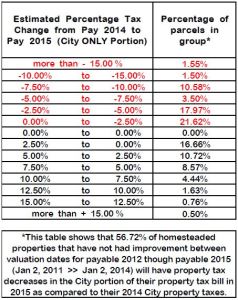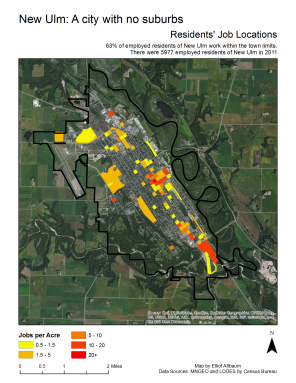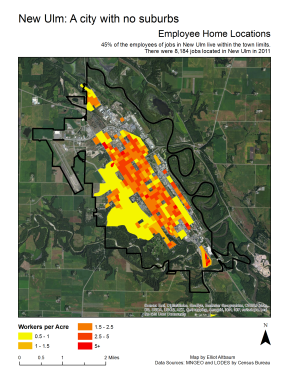The city budget negotiations this year sparked a public conversation about city finances and the details of budgeting. There was one piece missing, however, from the public conversation. It is the difference between the tax levy and the taxes levied. The former is the targeted budget set by the city. The latter is the method to reach that target. The difference between the two does make all the difference.
First, the levy. Each year the city sets a budget. The city decides how many new firefighters the city will hire and the number of bike lanes built. The city adds up all the services and infrastructure improvements to arrive at a grand total, the budget. The city then must raise the funds for that budget. Some of it comes from state and federal dollars and the largest share being from user fees (like garbage and recycling). Another major source of funding is property taxes. That’s called the tax levy. It is the total amount of money set to be raised by the city through property taxes in a year. It is one big number; in 2014 it was $281.7 million. The tax levy does not tell us about how and from whom the funds will be raised. It is simply the total amount to be raised by taxing the value of all properties in Minneapolis. Ok, that’s the tax levy.
Next, the taxes levied. Once the budget is decided and the tax levy set (the total budget), taxes are levied. The taxes levied on an individual property do not rise at the same rate as the tax levy; this is true for a couple of reasons*. First, new properties can be built in the city which increases the value of the total property in the city. This in turn lowers the taxes levied on each building, new and old. The second reason, the relative value of individual properties can change within the city. The effect of each on taxes levied will be explored in turn.
The construction boom in 2014 can help explain the first case. Throughout the city thousands of buildings were built. New single family homes, office buildings and apartment towers were built, totaling $2 billion dollars in value. This is a 2.4% increase in value of property in the city from the year before. This means there is that much more total property value which can share the cost of the tax levy. It is part of why 56.7% of property owners who have not made improvements to their home will see a decrease in the taxes levied on their property. The same thing can also be explained with a couple bags of M&Ms.
This means there is that much more total property value which can share the cost of the tax levy. It is part of why 56.7% of property owners who have not made improvements to their home will see a decrease in the taxes levied on their property. The same thing can also be explained with a couple bags of M&Ms.
Imagine you have 4 friends; 3 friends each have a one bag of M&Ms and the 4th with no bag. Your friend without a bag of candy could use some cheering up, so you each offer him 20 M&Ms, 5 each from you and your 3 friends. Along comes another friend, Felicia, who has a bag of candy too. She offers to also donate some M&Ms. Now with 5 friends, each person only needs to give 4 pieces. Sharing becomes easier with more friends.
Back to cities and not candy. When new buildings are built there is new value added to the city. This reduces the proportional contribution of property taxes by already existing properties. This means that when the whole city does better, we all do better.
Not all properties will see a reduction in taxes levied, however, because the amount of taxes levied also depends on the distribution of property values. Let’s return to the M&Ms. In the above example all the friends had the same sized bag of candy. Suppose instead one friend had a king sized bag as large as the other bags combined. That friend could have donated half the needed M&Ms. Property taxes are similar. The relative contribution of the value of a property to the city’s total also influences the taxes levied. Suppose the tax levy stays flat; from year to year the city needs to collect the same amount of money on properties in the city. A change in the relative value of a property will change the taxes levied on that property. If the value of a property grows slower than the city average, its relative value goes down and its taxes levied would go down. If the value of a property grows faster than the city average, its relative value goes up and its taxes levied would go up. This shows that sharing prosperity means we can share in the support of the city.
It is the interaction between these factors that show the wisdom of Wellstone’s old adage that “We all do better when we all do better”. We all live better when we expand opportunities so more neighbors can share our sidewalks. New neighbors and new homes spread the cost of the city to more people. We all live better when inequality is reduced because we can all contribute to the city we love. Our city does better when we all do better.
*There are many reasons, but these often only cover a small number of properties and are not part of the larger trends.
 Minneapolis needs a living wage. Each year thousands of students graduate from Southwest, Washburn, Edison, and all the Minneapolis schools. Each year many of those students reach for their future and head to college. Some come from families fortunate enough to not need loans; most do not. As difficult as navigating the challenges of finding and attending college, it is even more difficult to navigate scholarships, student loan offices, and high interest rates. This difficulty is real. Minnesota students have some of the highest levels of student loan debt in the
Minneapolis needs a living wage. Each year thousands of students graduate from Southwest, Washburn, Edison, and all the Minneapolis schools. Each year many of those students reach for their future and head to college. Some come from families fortunate enough to not need loans; most do not. As difficult as navigating the challenges of finding and attending college, it is even more difficult to navigate scholarships, student loan offices, and high interest rates. This difficulty is real. Minnesota students have some of the highest levels of student loan debt in the  The first map shows the job locations of workers who reside within New Ulm. Some of the workers who reside in New Ulm work in one of the many other small towns surrounding it. However, 63% of the 6977 New Ulm workers work in New Ulm. For a town that is only a couple square miles it means a large majority of residents could walk or bike to work. The southern area that is red is a more industrial area. The area in the middle of the map is downtown. Educational and medical facilities are represented by the large orange census blocks on the west side of town.
The first map shows the job locations of workers who reside within New Ulm. Some of the workers who reside in New Ulm work in one of the many other small towns surrounding it. However, 63% of the 6977 New Ulm workers work in New Ulm. For a town that is only a couple square miles it means a large majority of residents could walk or bike to work. The southern area that is red is a more industrial area. The area in the middle of the map is downtown. Educational and medical facilities are represented by the large orange census blocks on the west side of town. boundary of the town. As expected the areas outside of downtown are the major residential areas. 45% of the 8,184 jobs located within New Ulm are filled by residents of New Ulm. Most of the census blocks are relatively dense. These are the traditional city blocks that make up almost all of the city. The large yellow blocks on the western side of the city are newer developments that are the only traces of “suburbia”. They are also less dense likely because those blocks are also where the hospital and college grounds are located.
boundary of the town. As expected the areas outside of downtown are the major residential areas. 45% of the 8,184 jobs located within New Ulm are filled by residents of New Ulm. Most of the census blocks are relatively dense. These are the traditional city blocks that make up almost all of the city. The large yellow blocks on the western side of the city are newer developments that are the only traces of “suburbia”. They are also less dense likely because those blocks are also where the hospital and college grounds are located.